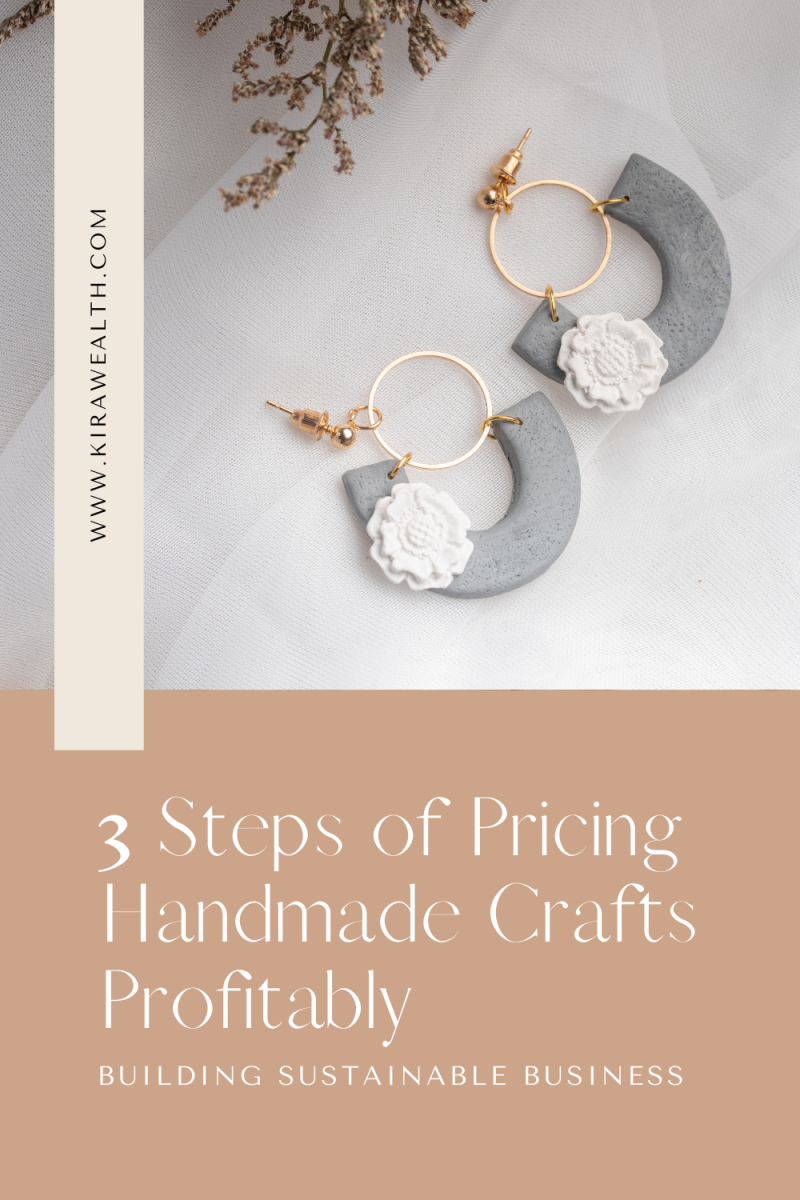3 Simple Steps of Pricing Handmade Crafts

Pricing handmade crafts can be complex and intricate process, especially for crafters who are just starting out their small businesses. Setting a profitable and competitive price for your crafts requires a thorough examination of multiple elements and factors. Let’s look at some of the costs to take into consideration before learning some pricing strategies for determining the right prices for your products.
Here, we have summarize this intricate process into 3 steps.
Step 1 Consider key costs
Step 2 What’s your pricing strategy
Step 3 Keep monitoring and adjusting
Step 1 Consider key costs of pricing handmade crafts
When pricing handmade crafts, there are several costs that should be taken into consideration to ensure that the final price is fair and profitable for the business.
Materials
Material refers to raw material used for creating your products. For handmade jewellery business, common raw materials will be natural stones / manmade beads, findings, metals and so on. If your craft involves crochet or embroidery, they will be fabric, yarn etc.. Material costs also includes supplies and tools. It is important to add in cost of packaging, e.g. boxes, bags, gift wrappings. They might seems insignificant but will be quite a sum that have an impact on your margin in bulk. When determining the price of your products, it is vital to take into account of the expenses incurred in acquiring these raw materials and supplies to create your masterpiece.
Labour
Craftsmanship and time are the main components of labour costs. Craftsmanship reflects your skill and experience in making your craft. It impacts the perceived value and quality of your product tremendously. When pricing your product, take into consideration of the craftsmanship involved. The complexity of the design, the skill required to create it, the level of attention to details needed. The more skillful and experienced you are, the higher the charges should be.
As the saying goes, time is money. The time spent creating the craft, as well as any additional time spent on design, research, and marketing should be taken into consideration as well.
Overhead
There are so many elements that make up overhead costs. Overhead costs include things like rent, utilities, insurance, salaries of non-production staff, advertising expense, and other expenses associated with running a business.
If you are running your business in brick-and-mortar store or pop-up store at crafter market, rent will be big component of overhead costs.
When your business has online presence, additional overhead costs will include website development and maintenance cost, hosting and domain costs, payment processing fee etc. These costs should be included in the final price to ensure that the business is sustainable.
Marketing
Marketing helps business to build brand awareness, attract new customers and retain existing customers. If no one knows about what you are offering, there won’t be any sales coming in. Reaching out to new customers and engaging with them helps to generate interest and drives sales. Loyalty programme and email marketing encourages repeat business from existing customers. How you can stand out from competitors depends on how well you position your business through marketing campaign. It’s important to research the competition, understand the market and have a sense of the price range of similar products.
Advertising expenses, market research and sales promotions are examples of marketing costs.
Shipping cost
For online sales, shipping cost should be incorporated into the final price. Free shipping entices customers to click on buy now button. High costs of shipping might deter customers from purchasing. Integrate this costs into your pricing and offer free shipping. This helps you to ensure your profitability while improving customer experience and increasing sales.
Profit / Markup
The maker should also consider the desired profit margin for the craft. The profit margin is the difference between the cost of the craft and the final selling price. Your business cash flow or liquidity depends on much on this part.
Taxes
Sales tax and any other taxes that may be applicable should also be taken into consideration.
By taking all of these costs into account, the maker can arrive at a fair and profitable price for the craft.
For easy calculation of your product pricing, visit here.

Step 2 Determine your pricing strategy
After listing down all the key costs, you know you should be getting more than the bare minimum for your business to sustain and markup for your business to flourish. Here are a few examples of pricing strategies to consider.
Cost-plus pricing
One of the most common pricing strategies for handmade products is cost-plus pricing. This approach involves adding a markup to the cost of materials and labor to determine the final price. For example, if the cost of materials and labor for a product is RM20, you might add a markup of 50% to set the final price at RM30. This approach is simple and straightforward. It ensures that you make a profit on each sale. However, it doesn’t take into account other factors such as competition, perceived value, and market demand.
Value-based pricing
Another approach to pricing handmade products is value-based pricing. This strategy involves setting the price based on the perceived value of the product to the customer. A handmade necklace made with high-quality gemstones and intricate design will be priced higher than a similar necklace made with manmade glass beads. This approach takes into account factors such as the quality of the materials, the skill required to create the piece, and the uniqueness of the design.
Premium pricing
For handmade products that are truly unique, luxurious or one-of-a-kind, premium pricing may be used. Set a high price for the product to reflect its exclusivity and luxury status. For example, a handmade artisanal piece of jewelry, made with rare and expensive materials, can be priced significantly higher than a similar, mass-produced piece.
Penetration pricing
For new businesses entering the market, or when launching a new product line, penetration pricing may be used. You set a lower price initially to attract customers and gain market share. As the business becomes more established, you may raise the prices.
Market-oriented pricing
Finally, market-oriented pricing involves looking at the prices of similar products in the market and adjusting your prices accordingly. This approach can be used to stay competitive and avoid pricing yourself out of the market. It’s important to keep in mind that the pricing strategy you choose will depend on the type of product you’re selling, the materials you’re using, and your target market.
Pricing handmade products can be a tricky task, but by understanding the different strategies available, you can make an informed decision. While the cost-plus pricing strategy is the simplest and most straightforward, it’s important to consider the perceived value of the product and market demand as well. Ultimately, the right pricing strategy for your handmade products will depend on your business goals, target market, and competition.
Step 3 Keep monitoring
A note on price war
It is generally not recommended for handmade products to engage in a price war. Handmade products typically have a higher value and perceived quality than mass-produced products. Pricing them too low can devalue the brand and perceived value.
By engaging in a price war, handmade crafters risk making their products a mere commodity. This will reduce them to just a price point.
Additionally, handmade products are often created by independent artisans or small businesses. They usually operates on smaller margins than large manufacturers. Engaging in a price war can put these small businesses at a disadvantage. They do not have a war chest to sustain their business if they have to constantly lower their prices.
It’s important to remember that the value of handmade products goes beyond the price tag. Customers who buy handmade products are often looking for something special, unique, and of high quality, and they are willing to pay more for it.
Instead, focus on building a strong brand and promoting the unique qualities of your handmade products. You can do this through storytelling, showcasing the process of creation, and highlighting your unique selling point. This can help to increase customer loyalty and build a strong customer base who are willing to pay a premium for them.


